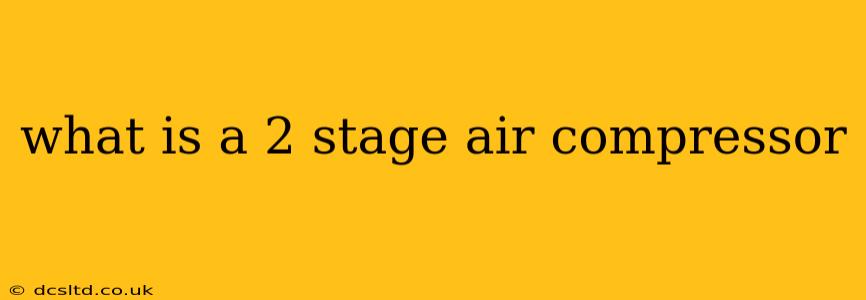A two-stage air compressor is a powerhouse of compressed air technology, offering superior performance and efficiency compared to its single-stage counterpart. Understanding its intricacies is key to appreciating its capabilities and choosing the right compressor for your needs. This comprehensive guide delves into the mechanics, advantages, and applications of two-stage air compressors, answering common questions along the way.
How Does a Two-Stage Air Compressor Work?
Unlike single-stage compressors that compress air in one step, a two-stage compressor divides the compression process into two distinct stages. This staged approach significantly reduces the work required for each compression cycle, resulting in several key benefits discussed later.
In the first stage, the intake air is compressed to an intermediate pressure. This partially compressed air then moves to a second cylinder where it undergoes a further compression to reach the final desired pressure. This sequential compression process is significantly gentler on the components, leading to increased longevity and efficiency. Each stage typically utilizes its own piston or diaphragm, depending on the compressor's design.
The key difference lies in the reduced heat generation. Compressing air generates heat, and excessive heat can damage the compressor's internal components and reduce efficiency. By splitting the compression, the two-stage design allows for cooling between stages, effectively mitigating heat buildup.
What are the Advantages of a Two-Stage Air Compressor?
Several advantages make two-stage compressors a popular choice for demanding applications:
-
Increased Efficiency: By breaking down the compression process, two-stage compressors achieve higher volumetric efficiency. This translates to more compressed air output for the same amount of energy input, reducing operating costs.
-
Extended Lifespan: The reduced heat and strain on components significantly extend the operational lifespan of the compressor. Less wear and tear mean fewer repairs and replacements.
-
Cooler Operation: The inter-stage cooling drastically lowers the operating temperature, improving the overall reliability and longevity of the system. This is crucial in demanding environments.
-
Higher Pressure Output: Two-stage compressors can achieve significantly higher pressure levels compared to single-stage units, making them ideal for applications requiring powerful air delivery.
-
Lower Noise Levels: While not always significantly quieter, the reduced stress on components in a two-stage design can often lead to quieter operation compared to a similarly-powered single-stage compressor.
What are the Disadvantages of a Two-Stage Air Compressor?
While two-stage compressors offer numerous advantages, there are some drawbacks to consider:
-
Higher Initial Cost: The more complex design and manufacturing process typically result in a higher initial purchase price compared to single-stage compressors.
-
Increased Complexity: The additional components and stages add to the complexity of the design, potentially making maintenance slightly more involved.
-
Larger Size and Weight: Due to the additional components, two-stage compressors are generally larger and heavier than single-stage units.
What are the Applications of a Two-Stage Air Compressor?
Two-stage air compressors are ideally suited for applications requiring high-pressure, consistent air delivery, and extended operational life:
-
Industrial Applications: Manufacturing, construction, and other industrial settings frequently utilize two-stage compressors for powering pneumatic tools and equipment.
-
Automotive Repair Shops: The demanding requirements of automotive repair often necessitate the power and reliability of a two-stage compressor.
-
Spray Painting: High-pressure, consistent air is crucial for achieving a professional finish in spray painting applications.
-
Sandblasting: Sandblasting demands high-pressure air for effective material removal, making two-stage compressors a suitable choice.
What is the Difference Between a Single-Stage and a Two-Stage Air Compressor?
The core difference lies in the compression process. A single-stage compressor completes the compression in a single step, leading to higher heat generation and potentially shorter lifespan. A two-stage compressor divides the compression into two stages, with cooling between stages, resulting in increased efficiency, longevity, and higher pressure output. The choice depends on your specific needs and budget.
Which is Better: Single-Stage or Two-Stage?
The "better" choice depends entirely on your specific application and requirements. Single-stage compressors are suitable for lighter-duty applications where cost is a primary concern. Two-stage compressors are the preferred choice for demanding applications requiring high pressure, consistent output, and extended lifespan, even if the initial investment is higher.
This comprehensive overview should provide a solid understanding of two-stage air compressors. Remember to carefully consider your specific needs and budget when selecting the right compressor for your application.
